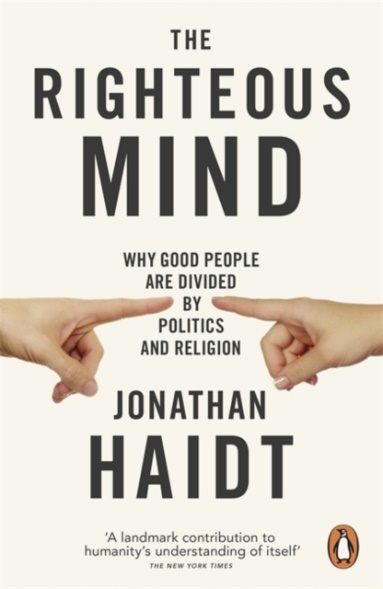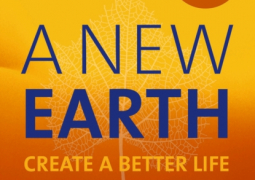
Reviewed by Rebecca Litchfield
Why do ideas such as ‘fairness’ and ‘freedom’ mean such different things to different people? Why is it so easy to see the flaws in others’ arguments, and less in our own? Jonathan Haidt argues that the reason we find it so hard to get along is because our minds are designed to be moral, and that we are hard-wired to be moralistic, judgemental and self-righteous too. Rebecca Litchfield finds that a key strength of the book is the way Haidt takes the reader through his own journey of moralistic discovery, drawing heavily on his own experiences and demonstrating how his own assumptions could be challenged and knocked down.
Haidt is a social and cultural psychologist who has spent sixteen years researching and teaching at the University of Virginia. This book is provocative and audacious, discussing ideas that aim to challenge many readers, particularly liberals. Having already worked on notions of what makes us happy in The Happiness Hypothesis: Finding Modern Truth in Ancient Wisdom, he has moved on to exploring why society has such trouble discussing religion, and why we can’t, in his own words, “make conversations about morality, politics and religion more common, more civil and more fun.” Haidt sees politics and religion as expressions of our underlying moral psychology, and he believes that an understanding of that psychology can help to bring people together. The Righteous Mind, therefore, examines where our morality might come from, why we think ‘ours’ differs from ‘theirs’, whether this is true, and perhaps most importantly, what we can do about it.
Haidt’s work comes at a point when global and cultural relations are increasingly tense. More and more politicians are using the polemic of us versus them, and the gap between liberal and conservative becomes wider and more hostile. Haidt approaches this divide with calm rationality and a genuine desire to learn about what causes this split, asking from where our morality might originate and what might make us unable to see the other point of view.
Haidt uses three metaphors to help explain his arguments, and splits the book into three main sections accordingly. He opens with a discussion of how humans are led by their intuition first and make their reasoning second, meaning that moral judgements are largely made post-hoc. Haidt asks the reader to imagine their mind as divided into two parts: a large elephant of automatic processes and intuition which then has a much smaller rider of controlled processes and reasoning, with the rider there to steer the elephant and to give reasons to our gut instincts.
He then argues that there is more to morality than fairness and harm. Haidt’s argument rests around six ‘moral foundations’ that he believes underlie human responses to scenarios: care, fairness, loyalty, authority, sanctity and liberty. Haidt believes that liberals place value on the first two whereas conservatives are more equally balanced across the six, which is why conservatives are able to appeal to a broader audience. The author’s second metaphor attempts to explain this: Haidt sees the righteous mind as like a tongue made up of six taste receptors – the six moral foundations. For example, in order to reach the broadest audience a politician must appeal to the elephant of a person’s righteous mind using as many of the receptors as they can. To highlight this point Haidt points out that the successful democratic candidates in American presidential campaigns, Clinton and Obama, spread their message across the moral foundations and “knew how to talk to elephants.”
Haidt’s final metaphor demonstrates that humans are naturally ‘groupish’ as well as selfish, and that this can mean that our morality can both bind and blind us. We are, as Haidt suggests, “90 per cent chimp, 10 per cent bee.” By this he means that whilst for the majority of the time we act with our own interests at heart, we all have a hive switch. In certain situations, we will act for the good of the team, whether this be politically, religiously, or simply in a football match. This final section draws the influences of Durkheim, Glaucon and Darwin. Haidt’s work heavily relies on Durkheim and Glaucon’s view of society – that structure and hierarchy is not necessarily negative, they prevent chaos or ‘anomie’ and that without fear of punishment (which can be as simple as gossip that would ruin a reputation), people do not act virtuously. He then adds to this Darwin’s notion that we evolved to operate at both the individual and group level, returning to Durkheim’s idea of the human race as “homo duplex”. Our morality is constructed accordingly: it has multiple facets that should be recognised if we are to relate to those who have different views to our own.
Haidt’s work has been criticized, particularly by liberals who struggle specifically with his admission that he realised he was a centralist when “the 9/11 attacks turned me into a group player with a powerful and unexpected urge to display my team’s flag.” They claim that he was forced by fear to go along with a republican attack on Islamic nations, and become a member of a “unthinking herd.” This criticism ignores the earlier sections where Haidt recounts his experiences of traveling in Odessa, and how it sparked in him the desire to question the assumptions he made about other people’s morality: living in their culture made him more able to see things from their point of view.
Indeed, one of the many strengths of The Righteous Mind is that Haidt takes the reader through his own journey of moralistic discovery, drawing heavily on his own experiences and demonstrating how his own assumptions could be challenged and knocked down. As a result, the book is colloquially written with a hint of self-deprecation that soon makes you warm to the author. This is inevitably a tool to get you on Haidt’s side, but it works, and works well. Similarly, this makes the difficult topics and disciplines covered throughout the book easier to digest. Haidt’s done his research, drawing not only on his own field of psychology, but genetics, philosophy, sociology, anthropology, and politics. The examples he uses are spread across all of these fields, and this makes his arguments more compelling.
Haidt is fundamentally trying to figure out why we can’t all just get along, and his conclusion, that we should start seeing things from other people’s point of view, is nothing ground-breaking. However, what is so impressive about this work is how he goes about demonstrating why this is such a difficult thing for us to achieve, and what the tools are that could make it possible. It’s a difficult read, not because of the style, but because the content may challenge you to accept that the “other side” isn’t so bad after all, and that perhaps your own moralistic mind could do with a shake-up.




